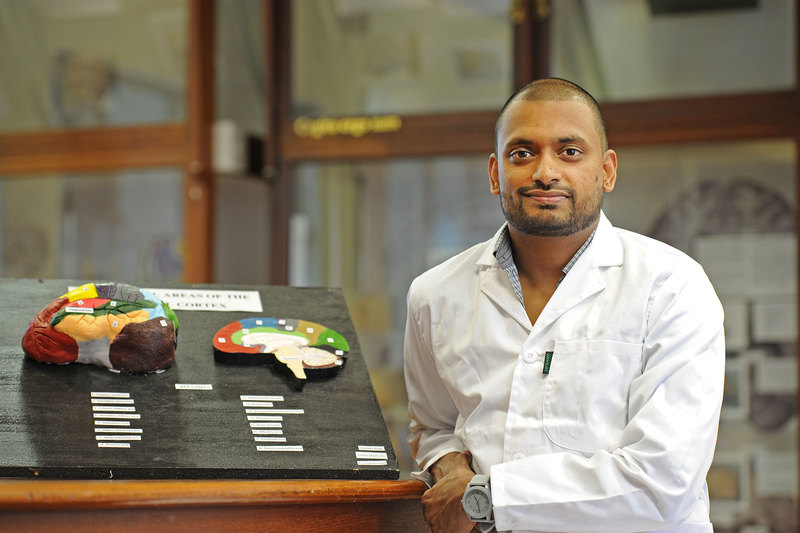Understanding the glymphatic system
17 March 2020 | Story Carla Bernardo. Photo Lerato Maduna. Read time 7 min.
Through his research, the University of Cape Town’s (UCT) Dr Adhil Bhagwandin, from the Division of Clinical Anatomy and Biological Anthropology, is hoping to better understand the neuroanatomy of the glymphatic system – the brain’s mechanism of removing the metabolic waste produced by neurons.
Bhagwandin is attempting to understand the glymphatic system in different animals to develop therapeutics to facilitate the management of neurological disorders and neurodegenerative diseases in both animals and humans.
He presented his research at the Neuroscience Institute’s inaugural research symposium, on 11 and 12 March, which followed the launch of UCT’s multidisciplinary Neuroscience Centre on 10 March.
Ahead of his presentation, titled “Glymphatics: A quest into the wild”, UCT News caught up with the neuroanatomist to find out more about his research and his academic journey.
Wealth of experience
While Bhagwandin’s research on the glymphatic system is still in its early stages, having started in 2017, the neuroanatomist brings a wealth of experience to the area.
He obtained his PhD from the University of the Witwatersrand (Wits) in 2011 with the aim of better understanding the evolution of the neuroanatomy of sleep. Following his PhD, he completed a combined postdoctoral fellowship at the University of California, Los Angeles (UCLA), and Moscow State University.
In 2014 he was the recipient of a Research Career Award from South Africa’s National Research Foundation. For the five-year duration of the award, Bhagwandin served as a senior researcher in Professor Paul Manger’s laboratory at Wits. In 2018 he joined UCT as a senior lecturer in the Division of Clinical Anatomy and Biological Anthropology.
Comparative research
For his PhD, Bhagwandin looked at different regions of the brain, specifically those known to be involved in generating sleep and wake, to comparatively understand their phylogenetic similarities and differences. Throughout his career, Bhagwandin has studied sleep in a range of vertebrates, particularly mammals – from elephants to mole rats – with his PhD focusing on the latter.
Continuing this comparative approach, Bhagwandin is now attempting to understand what the neuroanatomy of the glymphatic system looks like in the animals whose sleep he has already recorded in order to understand the resilience of the system in different sleep conditions. The resilience of the glymphatic system is, in this case, related to how it responds to different stressors and behaviours, such as sleep.
“Some questions include … How adaptable is this system? Does it stay the same across different animals or does it adapt according to that pattern of sleep that the animal has?” asked Bhagwandin.
By comparing different animal brains, Bhagwandin is able to further understand the similarities and differences in the sleep and wake system, as related to architecture and duration. Of interest to him is sleep, which is broken up into two components: rapid eye movement (REM) sleep and non-REM sleep.
Non-REM sleep is a larger component of the sleep cycle and is commonly referred to as deep sleep. It is during this stage that the glymphatic system appears to be most active, performing its function of clearing the brain of metabolic waste.
Bhagwandin aims to understand this in a phylogenetically comparative sense and then to try and relate it to humans.
Glymphatic system
Since the glymphatic system was only discovered in 2013 ─ in mice ─ there are a lot of unknowns.
However, there has been some insight into, for instance, Alzheimer’s disease, which occurs when there is a build-up of beta amyloids. Beta amyloids are waste products in the brain that act similarly to the plaque on teeth and are associated with causing damage to parts of the brain. The more ‘plaque’, the less the region of the brain can function, and this eventually results in neural death.
While research on the glymphatic system will not provide answers to all the questions surrounding Alzheimer’s disease, it helps researchers to understand how and at what rate beta amyloids are cleared from the brain.
There are also correlations between decreased glymphatic function and ageing, as well as between glymphatic system function and other neurodegenerative diseases, like Parkinson’s.
The benefit of Bhagwandin’s comparative research is that it will provide a different understanding of the brain and attempt to bridge the gap between humans and other mammals.
“Any brain is a very complex environment,” he said. “We’re trying to provide understanding to one arm of a holistic view and a holistic function.”
Bigger picture
One of the biggest challenges faced in neuroscience is carrying out research on rats and mice and then translating those findings to humans. While Bhagwandin does not say this practice is wrong, he doesn’t agree that it’s “completely correct” either.
“The problem is that there’s a roughly 50-million-year difference between humans and [rats and mice] in terms of evolution ... That’s a big gap,” he explained.
Rat and mouse brains are not small versions of humanoid brains; they are different, and so any conclusions and extrapolations should be made with this caveat in mind. The question is then: Which animal more accurately reflects the human condition, considering that primate research has been globally restricted?
This is where the neuroanatomist’s comparative research proves crucial. One of the goals of comparative research is to try and find other animals that can replicate the human condition and add this to the work being done with rats and mice to “understand the bigger picture”.
“The work that we [are trying] to do is to complement rat and mice work and develop a broader understanding,” said Bhagwandin. “And I think that with a broader understanding of anything, you can make more informed inferences into therapeutics and management of therapeutics.”
 This work is licensed under a Creative Commons Attribution-NoDerivatives 4.0 International License.
This work is licensed under a Creative Commons Attribution-NoDerivatives 4.0 International License.
Please view the republishing articles page for more information.
Research & innovation





































